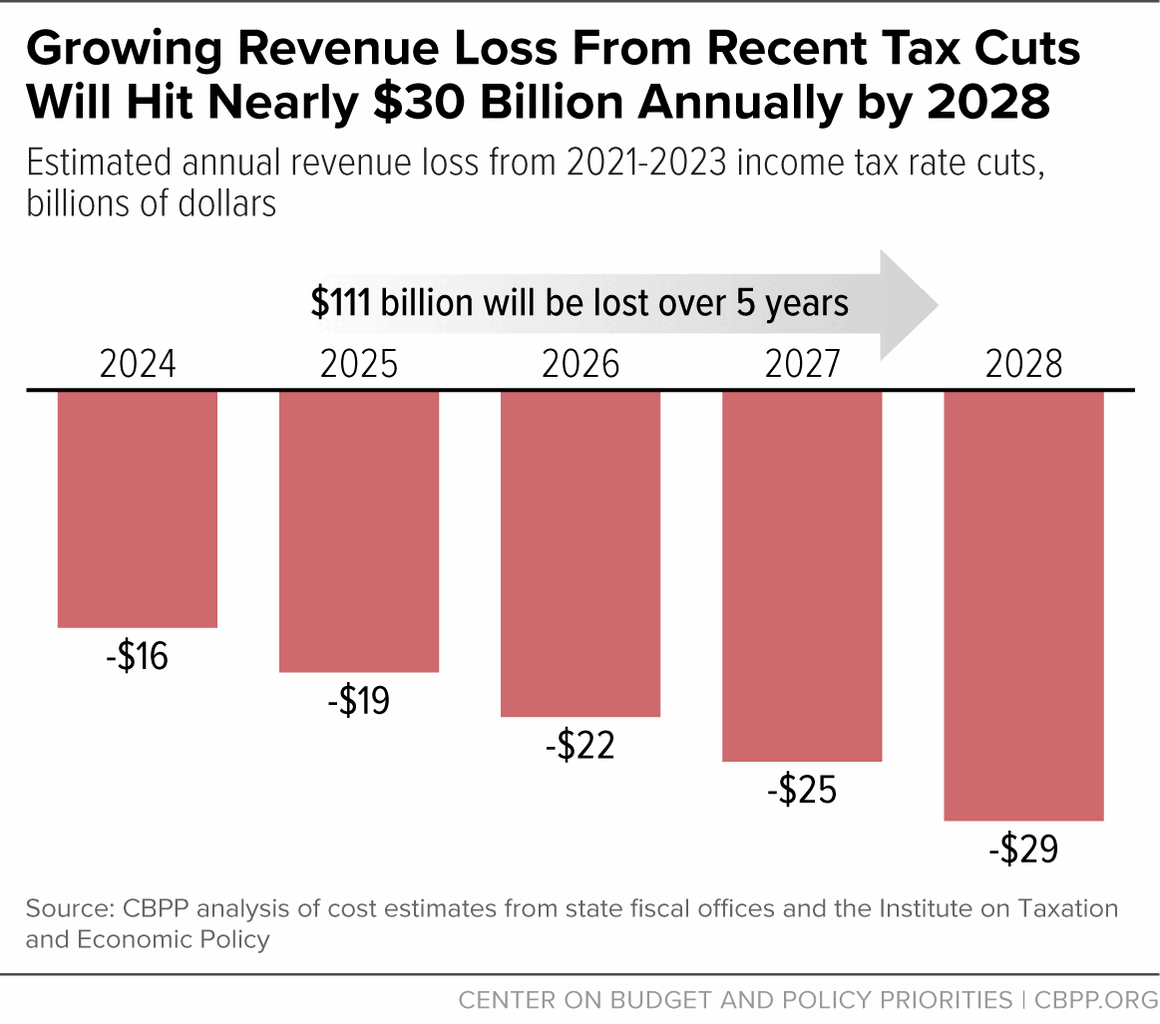BEYOND THE NUMBERS
As the 2024 legislative season starts, state policymakers again face a critical choice when it comes to tax policy: whether to pursue policies that ensure wealthy households and corporations pay their fair share and that vital public services are funded adequately, or to continue the recent trend of costly, regressive tax cuts that undermine their ability to meet people’s needs or invest in the future. With state revenues weakening and other risk factors on the horizon, states should reject calls for additional tax cuts and instead protect and raise revenues to support public services that help families and communities thrive.
Over the past three years, a wide swath of states have taken a counterproductive tax-cutting path: using the cover of temporary budget surpluses stemming from federal COVID-19 relief and the subsequent economic recovery to enact costly, regressive, and permanent cuts to their state income tax systems. But the federal relief has expired, and states have mostly spent the fiscal aid.
The fallout in lost revenue could be substantial. As our recent report detailed, 26 states cut personal and corporate income tax rates over the past three years. Those states stand to collect an estimated $111 billion less over the next five years than they otherwise would have, with the price tag in lost revenues hitting nearly $30 billion a year by 2028 (see graphic). The damage is already starting to show up on some state balance sheets.
Tax cuts on that scale could translate into serious harm, especially at a time when state budgets are under increasing strain from a host of factors, including expiring federal relief funds and a modestly cooled economy. Shrinking revenues will jeopardize current levels of state support for vital public services like schools, health services, and income support programs. They will also constrain states’ future potential by limiting policymakers’ ability to make new investments to tackle unmet or emerging needs and issues, such as child poverty, the health of pregnant or postpartum people, or housing affordability.
Consider some examples:
- In Arkansas, policymakers enacted four rounds of personal and corporate income tax cuts in 2021, 2022, and 2023, choosing to forgo more than $4 billion over the next five years and the investments in children and families those dollars could have supported. For the annual cost of just the cuts enacted in spring 2023 alone, policymakers could have created an eight-week paid parental leave program for all parents in the state.
- Lawmakers in Kentucky, meanwhile, approved sweeping income tax cuts in 2022 and 2023 that combined will cost more than the state spends on its entire system of colleges and universities each year. The plan also includes a “trigger” designed to pave the way for eventual elimination of the personal income tax.
- In West Virginia, a massive 2023 tax plan is already exacerbating shortfalls in college funding and other services. Those tax cuts also cost roughly twice what it would take to eradicate child poverty in the state, according to one estimate.
In three states — Arizona, North Carolina, and West Virginia — income tax cuts passed in the past three years are comparable in scope to the disastrous “Brownback tax cuts” adopted in Kansas in the 2010s, which decimated that state’s public services, failed to deliver a promised economic boost, and were eventually overturned by a bipartisan supermajority. Several other states are close behind in terms of the scale of future costs.
Fortunately, a few other states have recently shined a light on a different, brighter path of protecting and raising revenues to support current services and new investments.
- In Massachusetts, for instance, voters in 2022 approved a new top tax rate on incomes above $1 million that’s expected to eventually raise at least $2 billion annually for improving public schools and transportation. It’s already allowing policymakers to do things like enhance and expand public transit service, bolster free community college programs and university scholarships, and retrofit K-12 schools to be more energy efficient and environmentally healthy.
- In Minnesota, policymakers in 2023 enacted measures to crack down on corporate tax avoidance and collect more from people with the state’s highest incomes. Those policies will help fund an ambitious set of social and economic policies including universal free meals for public school students and a new paid leave program.
- And in Washington State, a new excise tax on income from the sale of stocks and other investments — paid exclusively by the wealthiest 0.2 percent of taxpayers — is directing at least half a billion dollars in new revenue each year (and potentially much more) to build and repair K-12 schools and expand child care and early learning supports for young children.
These three aren’t alone: states including Colorado, Maine, New Jersey, New York, and Vermont, and the District of Columbia have also raised new revenues to fund initiatives like universal free school meals, expanded child care and paid leave, and more affordable housing options.
More states should follow suit in 2024 and beyond. While slashing income taxes tilts the balance of economic and political power further toward wealthy people and special interests and weakens states’ ability to thrive, boosting tax revenue in sound, targeted ways and reinvesting the money in people and communities are among the best ways for states to enhance their long-term promise. It enables states to reduce poverty and expand economic opportunity as well as enhance their residents’ overall quality of life and potential for long-term, broad-based prosperity. Progressive tax systems and durable support for public services are also vital for advancing racial justice and helping to protect the pillars of a healthy democratic process.
With a range of targeted policies at their disposal, state policymakers are well positioned to take this brighter path: they should seize the opportunity to break the tax-cut fever and pivot in a more equitable, prosperous, responsible, and forward-looking direction.

